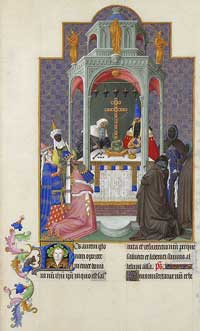 Holy Cross Day, September 14, is called in Greek Ὕψωσις τοῦ Τιμίου Σταυροῦ (literally, “Raising Aloft of the Precious Cross”). In Latin it is called Exaltatio Sanctae Crucis (literally, “Raising Aloft/Exaltation/Triumph of the Holy Cross”.
Holy Cross Day, September 14, is called in Greek Ὕψωσις τοῦ Τιμίου Σταυροῦ (literally, “Raising Aloft of the Precious Cross”). In Latin it is called Exaltatio Sanctae Crucis (literally, “Raising Aloft/Exaltation/Triumph of the Holy Cross”.
The True Cross is said to have been discovered in 326 by Helena, mother of Constantine. The Church of the Holy Sepulchre was built at the site. The cross itself was brought outside the church on September 14, 335, in the festival of dedication of the church.
Traditionally, in the Christian West, the Wednesday, Friday, and Saturday of the calendar week after the one in which 14 September falls were Ember days. Traditionally Holy Cross Day is the start of Monastic Lent. The Southern Hemisphere, in search of inculturation into our context, could be making much more of this as our “Liturgical Spring”; and the approximately 40 days between now and All Saints could incorporate Northern Hemisphere Spring (Lent) traditions which don’t work so well in our Lenten Autumn (Fall).
Almighty God,
whose Son our Savior Jesus Christ was lifted high upon the cross
that he might draw the whole world to himself:
Mercifully grant that we, who glory in the mystery of our redemption,
may have grace to take up our cross and follow him;
who lives and reigns with you and the Holy Spirit, one God, in glory everlasting.
The sign of the cross part 1; part 2; part 3
Last year’s blog on Holy Cross Day
BASILICA OF SAN FRANCESCO, Frescoes of the Legend of the True Cross by Piero della Francesca, AREZZO



